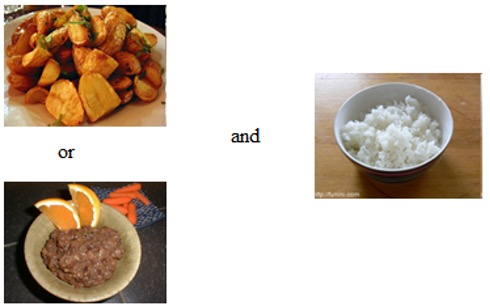Subsection 7.2.2 Structural Ambiguity
A very common source of ambiguity is structural: There may be more than one syntactic parse (structure) for a sentence. Each parse corresponds to a different meaning.
We’ve already looked at a lot of examples in which ambiguity arises from the lack of parentheses in English.
Recall that: pancakes or bacon and eggs
could mean:
pancakes or (bacon and eggs)
or
(pancakes or bacon) and eggs
or
A second source of structural ambiguity is postmodifiers (modifiers that come after whatever they modify). The problem is that those modifiers have to get attached to the constituents they modify. There may be more than one way to do that. Prepositional phrases often cause this kind of ambiguity.
Consider: Chris likes the girl with a cat.
Anyone who reads this sentence is going to assume that the prepositional phrase, “with a cat” modifies, “the girl”. There’s a girl with a cat and Chris likes her. So we get:
But now, suppose that we replace “like” with “shot”, “girl” with “bear”, and “cat” with “rifle”.
We get: Chris shot the bear with a rifle.
Should we get the same structure?
If we parse it the same way, we get:
Cute. But almost surely not what was meant. Instead, in this case, we want to attach the prepositional phrase, “with a rifle,” not to “the bear,” but to the verb phrase, “shot the bear”. The parse tree we need is this one:
Now the prepositional phrase (as is common when such phrases modify verb phrases) says something about the way in which the action (shooting) happened.
English syntax would have allowed us to produce a parse tree like this for the first sentence as well. In other words, we could have attached, “with a cat,” to the verb, “likes”, but that wouldn’t have made sense – you can’t like using a cat.
So the problem is that the syntax (grammar) of English allows prepositional phrases to be attached in many different ways. In the case of most sentences, only one of the possible attachments makes sense. We (people) jump directly to it. But we must be careful, when we assert that the meaning of a given sentence is some particular logical claim, that we are clear on which parse we are assigning that meaning to.
Exercises Exercises
1.
Consider: You can have potatoes or beans and rice.
Which of the following possible parenthesizations is almost certainly the one that is intended:
-
potatoes OR (beans AND rice)

-
(pancakes or bacon) and eggs

2.
Consider: Kim ate the fried chicken with a fork.
The prepositional phrase, “with a fork,” modifies:
The direct object (“the fried chicken”)
The verb phrase (“ate the fried chicken”)
3.
Consider: Tracy likes books with surprise endings.
The prepositional phrase, “with surprise endings,” modifies:
The direct object (“books”)
The verb phrase (“likes books”)



